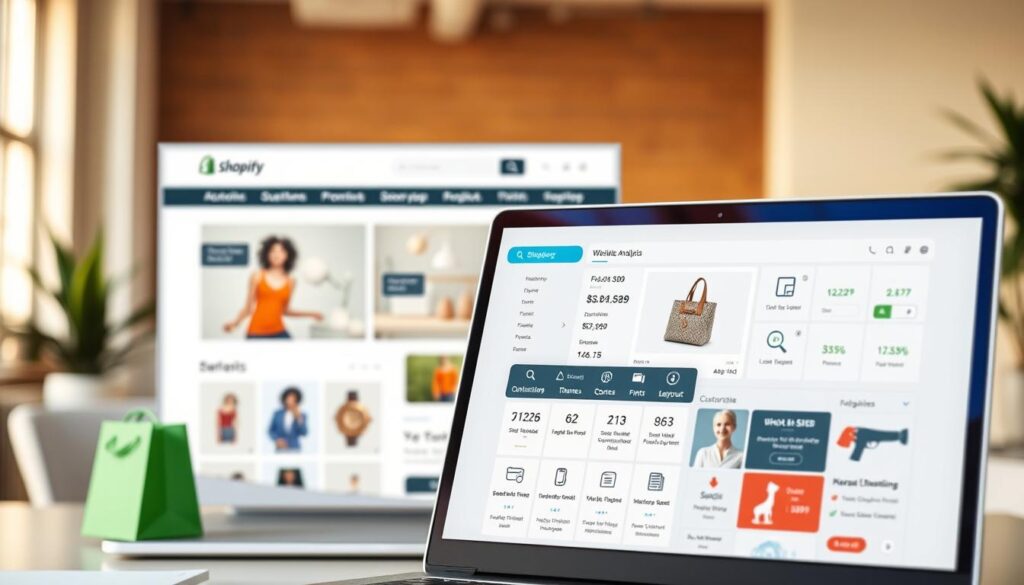Ever wondered why some online stores do great while others struggle? It might be because of how they set up their Shopify store. Shopify is easy to use and packed with features, making it a top choice for new business owners. This Shopify store setup guide will help beginners get started smoothly.
Launching your online store in just a few days is possible with Shopify. They offer a free trial and deals like $1 for the first three months. You’ll see that creating a great online store is easier than you think. This guide will show you how to pick themes, add products, and set up payments, making your business dreams come true.
Understanding the Basics of Shopify
Starting an online business? Knowing the basics of Shopify is key. This platform makes creating an online store easy. It’s great for both new and established businesses. We’ll cover what Shopify is, its features, and pricing. This will help you set up your Shopify store.
What is Shopify?
Shopify is a full-featured eCommerce platform. It helps users create online stores easily. It lets entrepreneurs manage inventory, process payments, and talk to customers all in one place.
Key Features of Shopify
Shopify has many features that set it apart. Key ones include:
- A user-friendly interface for easy navigation
- Customizable themes for a unique look
- Many payment options to meet customer needs
- Strong inventory management tools
- Mobile-friendly templates for easy access
These features make Shopify stores great. A Shopify setup checklist helps ensure everything is covered when setting up your store.
Pricing Plans Overview
Shopify has different pricing plans for various business sizes. Prices range from $29 to $299 a month. This lets businesses choose the right plan for their budget and grow without losing quality. Here are the main plans:
| Plan Name | Monthly Cost | Features Included |
|---|---|---|
| Basic Shopify | $29 | Online store, unlimited products, 24/7 support |
| Shopify | $79 | All Basic features plus professional reports |
| Advanced Shopify | $299 | All Shopify features plus advanced report builder |
Creating Your Shopify Account
Starting your Shopify website setup begins with creating an account. This first step is key for those new to e-commerce. We’ll guide you through signing up, choosing a plan, and picking a store name. These steps are essential for a successful Shopify setup.
Sign Up Process
First, go to Shopify.com. You’ll see the chance to start a free three-day trial. You’ll answer important questions about your business, like what you’ll sell. This helps Shopify tailor your experience. Just fill out the form to set up your account.
Choosing a Subscription Plan
After creating your account, pick a subscription plan that fits your business. Shopify has many plans for different sellers. Think about how much you expect to sell and what features you need. This choice affects your costs and what you can do as your store grows.
Setting Up Your Store Name
The last step is choosing your store name. This is a big deal for your brand. A good name helps customers remember you and boosts your online presence. Take your time to find a name that shows what your business is about.
Customizing Your Shopify Store Design
Creating a visually appealing Shopify store is key to engaging customers. The design of your store can greatly affect user experience and brand recognition. Start by choosing a theme that fits your brand and appeals to your target audience.
Selecting a Theme
Shopify offers many themes, both free and paid. You can customize your store based on your vision. When picking a theme, think about its relevance to your industry, features like infinite scroll, and how versatile it is. Make sure the theme works well on mobile devices too.
Customizing Your Theme Layout
The Shopify theme editor is easy to use, even if you don’t know how to code. You can:
- Adjust layouts with Sections Everywhere.
- Embed apps to add more functionality.
- Create page templates for different categories.
This lets you personalize your storefront fully. You can tailor it to your customers’ preferences while keeping a consistent design strategy. For more tips, check out the Shopify theme customization guide.
Adding Your Logo and Brand Colors
Adding a well-designed logo and consistent brand colors can boost recognition. Choose colors that appeal to your target audience and ensure they match throughout the site. Also, pick fonts that are easy to read, like Helvetica and Times New Roman. For more ideas on customizing your store, visit this guide on Shopify themes.

Adding Products to Your Store
Managing product listings is key to a successful Shopify store. You need to list products, organize collections, and set up variants. Each step boosts user experience and sales.
How to List Products
Start by going to the Shopify admin panel. Add product titles, descriptions, and prices. Keep titles under 70 characters for better search.
Descriptions should be short, under 320 characters. Use SEO-friendly URLs for better rankings. Follow these Shopify store creation tips for better search.
Organizing Your Product Collections
Organization is vital for product management. Create collections to segment products for easier navigation. This boosts user engagement and sales.
Use categories like bestsellers or seasonal items. Make sure collections meet customer expectations and browsing habits.
Setting Up Product Variants
Product variants offer different options like color, size, or material. Each variant can have its own price and stock. This streamlines inventory management.
Setting up variants well caters to customer preferences. It enhances their shopping experience and boosts your store’s sales. Keeping your inventory organized helps in creating a successful Shopify store.

Setting Up Payments and Shipping
Understanding the back-end tasks for payments and shipping is key for a smooth customer experience. This is vital for making your Shopify store successful. You’ll need to set up reliable payment gateways and structure your shipping rates well.
Payment Gateway Options
Integrating various payment gateways can greatly benefit your online store. Shopify Payments supports credit card transactions, bank transfers, and fast checkouts. This makes buying easier for customers. You should also consider PayPal and other third-party options to build trust and expand your payment options.
For more on setting up Shopify Payments, check out this resource.
Configuring Shipping Rates
Getting shipping rates right is key for happy customers. Make sure your shipping costs are clear to avoid surprises at checkout. Set up shipping zones, rates, and carriers carefully.
Offering different shipping options can meet various customer needs. This can improve the shopping experience and help your store succeed.
Managing Taxes and Compliance
Tax compliance is complex but necessary for e-commerce. Shopify makes it easier by automating tax calculations based on your location. This saves time and reduces the risk of tax penalties.
By tackling these back-end tasks, you’re setting your Shopify store up for success. This ensures a smooth launch and ongoing operation.
FAQ
How long is the free trial for Shopify?
Shopify gives you a three-day free trial. This lets you try out the platform without spending money right away.
What are the different pricing plans available on Shopify?
Shopify has plans from to 9 a month. These plans fit different business sizes and sales levels. They grow with your business.
Can I customize the design of my Shopify store?
Yes, you can. Shopify makes it easy to change your store’s look. You don’t need to be tech-savvy to do it.
What payment gateways can I use with Shopify?
Shopify works with many payment options. You can use Shopify Payments, PayPal, and other third-party services. This flexibility suits various businesses.
How can I enhance the search visibility of my products?
To boost search visibility, use SEO-friendly URLs and detailed product descriptions. Also, include relevant keywords in your listings.
Is it important to have a mobile-responsive store?
Yes, it’s very important. A mobile-friendly design improves user experience. It also meets the needs of more mobile shoppers.
How do I manage taxes on my Shopify store?
Shopify makes tax management easy. It has features for handling taxes in different areas. This simplifies tax handling for store owners.
What should I consider when choosing a store name?
Your store name is key to your brand. Pick a name that’s easy to remember. It should connect with your target audience and help customers remember you.
Can I set up product variants in my Shopify store?
Yes, you can. Product variants let customers choose different options for each item. This can make shopping better and might increase sales.
I’m into tech, trends, and all things digital. At CrazeNest, I share what’s new, what’s next, and why it matters — always with a curious mind and a creative twist.





